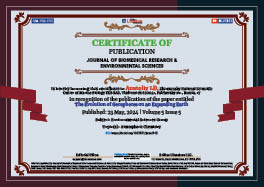Burundukov AS and Drozdov AL*
Volume5-Issue5
Dates: Received: 2024-05-09 | Accepted: 2024-05-22 | Published: 2024-05-23
Pages: 445-449
Abstract
The evolution of the geosphere is considered in the light of the expanding Earth hypothesis, an alternative concept of plate tectonics, the fifth axiom of which is the statement about the immutability of the mass and size of the Earth, as well as the mass of water on its surface. A new look at the evolution of the Earth and its geospheres (lithosphere, hydrosphere, cryosphere and biosphere.) is proposed. The physical mechanisms of the not yet understood processes of increasing its size with a simultaneous increase in mass are discussed. For the first time, a physical scenario of the expansion process is proposed. It consists in the constant absorption of dark matter by the Earth in the form of quark nuggets (strangelets), followed by their decay and transformation into ordinary matter. The expansion of the Earth makes it possible to explain not only the large size and mass of land animals at the end of the Paleozoic and Mesozoic, but also to establish the most probable causes of the movement of continents and Great Extinctions.
FullText HTML
FullText PDF
DOI: 10.37871/jbres1913
Certificate of Publication

Copyright
© 2024 Burundukov AS, et al. Distributed under Creative Commons CC-BY 4.0
How to cite this article
Burundukov AS, Drozdov AL. The Evolution of Geospheres on an Expanding Earth. J Biomed Res Environ Sci. 2024 May 23; 5(5): 445-449. doi: 10.37871/jbres1913, Article ID: JBRES1913, Available at: https://www.jelsciences.com/articles/jbres1913.pdf
Subject area(s)
References
- Burundukov AS, Drozdov AL. Giant lizards - A paleontological challenge to interdisciplinary synthesis. Biota and environment of reserves of the Far East. 2015;5:93-113.
- Burundukov AS, Drozdov AL, Kazansky BA. Paleontological paradox - Gordian knot of global evolutionism. LAMBERT Academic Publishing. 2016;298.
- Drozdov AL. Biology for physicists and chemists. Vladivostok: Publishing House of the Far East. University. 2005;404.
- Drozdov AL, Burundukov AS. The concept of Earth growth resolves the paleontological paradox in the context of global evolution. Questions of geography. Sat. 149. Co-temporal Earth science. Kotlyakov VM, Dyakonov KN, Reteyum AYM, editors. Publishing house "Codex"; 2019. p.178-198.
- Burundukov AS. The decay of quark nuclei induced by solar neutrinos as a mechanism for the expansion of the Earth. Materials of the 66th All-Union Scientific Conference. Volume III. Fundamental and Applied Issues of Natural Science; 2023. p.14-25.
- Hilgenberg OC. Von wachsenden Erdball (The expanding Earth). Berlin: Giessmann & Bartsch. 1933;56.
- Blinov VF. The Growing Earth: From planets to stars. Editorial URSS; 2003. p.272.
- Larin VN. The hypothesis of an initially hydride Earth. Subsoil. 1980;216.
- Benson Emily World's oldest ocean crust dates back to ancient supercontinent. New Scientist. 2016.
- Hoyle F. A new model for the expanding universe. Mon Not Roy Astron Soc. 1948;108:372-382.
- Bondi H, Gold T. The steady-state. Theory of the Expanding Universe. Mon Not Roy Astron Soc.1948;108:252.
- Carey SW. Theories of the earth and universe. Stanford University Press; 1988. p.413.
- Dirac PAM. The cosmological constants. Nature. 1937;139(3512):323.
- Akhavan O. The universe creation by electron quantum black holes. Acta Scientific Applied Physics (ASAP). 2022;2:34-45.
- Navarro J, Carlos SF, Simon DMW. A Universal Density Profile from Hierarchical Clustering Архивная копия от 4 июня 2016 на Wayback Machine. 1997.doi: 10.48550/arXiv.astro-ph/9611107.
- Burkert A. The structure of dark matter halos in dwarf galaxies. Astrophysical Journal Letters. 1995;447:L25-L28. doi:10.1086/309560.
- Moore B, Quinn T, Governato F, Stadel J, Lake G. Cold collapse and the core catastrophe. Monthly Notices of the Royal Astronomical Society. 1999;310(4):1147-1152. doi: 10.1046/j.1365-8711.1999.03039.x.
- Einasto J. Kinematics and dynamics of stellar systems, Trudy Inst. Astrofiz. Alma-Ata. 1965;5:87
- Lawson K. Quark nugget dark matter: cosmic evidence and detection potential. Proceedings of the International Symposium on Very High Energy Cosmic Ray Interactions. 2014.
- N. Raza, van Waerbeke L, Zhitnitsky A. Solar corona heating by axion quark nugget dark matter. Phys Rev. 2018;98:103527. doi: 10.1103/PhysRevD.98.103527.
- Rosa LEM, Isbell JL. Late Paleozoic glaciation. In: Alderton, David; Elias, Scott A, editors. Encyclopedia of Geology (2nd ed.). Academic Press; 2021. p.534-545. doi:10.1016/B978-0-08-102908-4.00063-1.
- Torsvik TH, Smethurst MA, Burke K, Steinberger, B. Long term stability in deep mantle structure: Evidence from the ~300 Ma Skagerrak-Centered Large Igneous Province (the SCLIP). Earth and Planetary Science Letters. 2008;267(3):444-452. doi: 10.1016/j.epsl.2007.12.004.
- Sahney S, Benton MJ, Falcon-Lang HJ. "Rainforest collapse triggered Pennsylvanian tetrapod diversification in Euramerica" (PDF). Geology. 2010;38(12):1079-1082. doi: 10.1130/G31182.1.
- Saunders A, Reichow M. The Siberian Traps and the End-Permian mass extinction: A critical review. Chinese Science Bulletin. 2009;54(1):20-37. doi:10.1007/s11434-008-0543-7.
- Ernst RE, Youbi N. How Large Igneous Provinces affect global climate, sometimes cause mass extinctions, and represent natural markers in the geological record. Palaeogeography, Palaeoclimatology, Palaeoecology. 2017;478:30-52. doi: 10.1016/j.palaeo.2017.03.014.
- Encarnación. Early rifting and Gondwana breakup. 1996;537-538.
- Seton. South Atlantic. 2012;217-218.
- Jennifer Chu. What really killed the dinosaurs? MIT News Office. 2014.
- England MH, Hutchinson DK, Santoso A, Sijp WP. Ice - Atmosphere feedbacks dominate the response of the climate system to Drake Passage closure. Journal of Climate. American Meteorological Society: 5775. 2017;30(15). doi: 10.1175/JCLI-D-15-0554.1.
- https://www.newworldencyclopedia.org/entry/Arctic_Ocean






























































